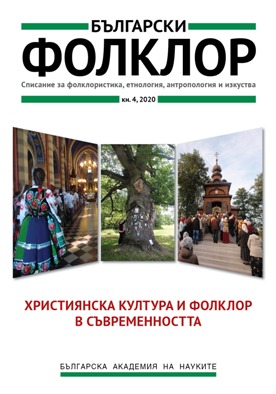Трансформации на фолклорната и религиозната култура в Странджа през призмата на обичая Еньова буля и култа към св. Модест
Transformations of Folklore and Religious Culture in Strandzha Mountain through the Lens of Enyova Bulya Custom and the Cult of St. Modest
Author(s): Mira MarkovaSubject(s): Christian Theology and Religion, History, Anthropology, Social Sciences, Economy, Literary Texts, Fine Arts / Performing Arts, Cultural history, Customs / Folklore, History of Church(es), Poetry, Geography, Regional studies, Micro-Economics, Agriculture, Visual Arts, Human Geography, Regional Geography, Sociology, Local History / Microhistory, Oral history, Social history, Theology and Religion, Cultural Anthropology / Ethnology, Culture and social structure , Social development, Demography and human biology, Rural and urban sociology, Sociology of Culture, Eastern Orthodoxy, Migration Studies, Socio-Economic Research, Sociology of Religion, History of Religion, Identity of Collectives
Published by: Институт за етнология и фолклористика с Етнографски музей при БАН
Keywords: Enyova bulya; ritual; custom; St. Modest; local culture
Summary/Abstract: Over the last decades, the Strandzha region suffers a serious demographic crisis and the outflow of population results in significant change in the local culture. The empirical data of the current research is based on fieldwork in villages of Fakia (Central Strandzha, Sredets Municipality). The aim is to give a picture of the current condition of the folklore and religious culture through symbolic and specific phenomena. Enyova bulya custom is widely spread in Strandzha region and is conceived as an accent in the Enyovden (Yanovden) celebrations that take place on the 24th of June and is one of the main summer feast days until the ’60s of the 20th century. Enyova bulya is associated with fertility, maiden's transition and the well-being of the settlement community. Today, the custom is disconnected from the context of the festive life of the researched community as far as the world view of the main actors has been changed. Main doers are elderly women, the time of the celebrations is not exactly fixed thus the sacredness of the actions is automatically degenerated. A conclusion can be made that the custom nowadays has the characteristics of a tourist attraction in some aspects. Keeping the celebrations is perceived as a need to declare local identity and local diversity. The transformations in the religious culture of the researched community can be analysed in a similar direction. St. Modest cult (celebrated on December 18) is seen as “typical only for Strandzha region”. In the past, the cult is related to the local livelihood – livestock-raising and agriculture. For example, in Fakia village is believed that the woman that gives out ritual bread first will be the first to finish harvesting. Today, as a result of drastic changes in livelihood, the cult exists as a characteristic of local religious culture – grounds for the local dimensions of cultural identity. Anyway, ritual practices serve the local identity. Searching a motivation in tradition keeps alive a local peasant community in process of dramatic demographic and social crises in Strandzha region.
Journal: Български фолклор
- Issue Year: XLVI/2020
- Issue No: 4
- Page Range: 393-410
- Page Count: 18
- Language: Bulgarian
- Content File-PDF

